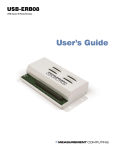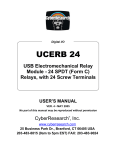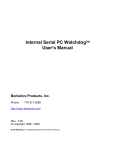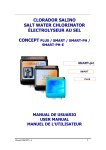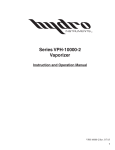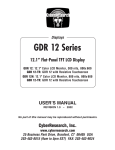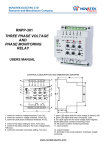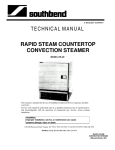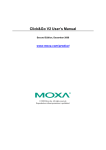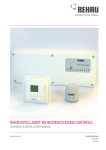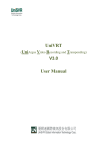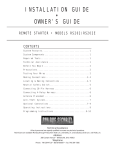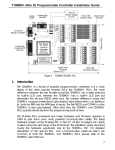Download CyberResearch UCERB 24 User`s manual
Transcript
® Digital I/O UCERB 08 USB Electromechanical Relay Module - 8 SPDT (Form C) Relays, with 24 Screw Terminals USER’S MANUAL VER. 4.0 • MAY 2005 No part of this manual may be reproduced without permission ® CyberResearch , Inc. www.cyberresearch.com 25 Business Park Dr., Branford, CT 06405 USA 203-483-8815 (9am to 5pm EST) FAX: 203-483-9024 UCERB 08 User’s Guide ©Copyright 2005 All Rights Reserved. May 1, 2005 The information in this document is subject to change without prior notice in order to improve reliability, design, and function and does not represent a commitment on the part of CyberResearch, Inc. In no event will CyberResearch, Inc. be liable for direct, indirect, special, incidental, or consequential damages arising out of the use of or inability to use the product or documentation, even if advised of the possibility of such damages. This document contains proprietary information protected by copyright. All rights are reserved. No part of this manual may be reproduced by any mechanical, electronic, or other means in any form without prior written permission of CyberResearch, Inc. Trademarks “CyberResearch®,” and “UCERB 08,” are trademarks of CyberResearch, Inc. Other product names mentioned herein are used for identification purposes only and may be trademarks and/or registered trademarks of their respective companies. • NOTICE • CyberResearch, Inc. does not authorize any CyberResearch product for use in life support systems, medical equipment, and/or medical devices without the written approval of the President of CyberResearch, Inc. Life support devices and systems are devices or systems which are intended for surgical implantation into the body, or to support or sustain life and whose failure to perform can be reasonably expected to result in injury. Other medical equipment includes devices used for monitoring, data acquisition, modification, or notification purposes in relation to life support, life sustaining, or vital statistic recording. CyberResearch products are not designed with the components required, are not subject to the testing required, and are not submitted to the certification required to ensure a level of reliability appropriate for the treatment and diagnosis of humans. CyberResearch, Inc. 25 Business Park Drive Branford, CT USA iii P: (203) 483-8815; F: (203) 483-9024 www.cyberresearch.com UCERB 08 Intentionally Blank iv ©Copyright 2005 CyberResearch, Inc. Table of Contents Preface About this User’s Guide ......................................................................................................................vi What you will learn from this user’s guide........................................................................................................vi Conventions in this user’s guide........................................................................................................................vi Chapter 1 Introducing the UCERB 08................................................................................................................ 1-1 Overview: UCERB 08 features....................................................................................................................... 1-1 UCERB 08 block diagram .............................................................................................................................. 1-1 Software features ............................................................................................................................................ 1-2 Connecting a UCERB 08 to your computer is easy ........................................................................................ 1-2 Chapter 2 Installing the UCERB 08.................................................................................................................... 2-1 What comes with your UCERB 08 shipment? ................................................................................................ 2-1 Hardware ....................................................................................................................................................................... 2-1 Software......................................................................................................................................................................... 2-1 Documentation............................................................................................................................................................... 2-2 Unpacking the UCERB 08 .............................................................................................................................. 2-2 Installing the software .................................................................................................................................... 2-2 Installing the UCERB 08 ................................................................................................................................ 2-2 Configuring the hardware switches................................................................................................................................ 2-2 Connecting the external power supply ........................................................................................................................... 2-4 Connecting the UCERB 08 to your system .................................................................................................................... 2-4 Chapter 3 Functional Details ............................................................................................................................. 3-1 Internal components ....................................................................................................................................... 3-1 USB in connector........................................................................................................................................................... 3-1 USB out connector......................................................................................................................................................... 3-1 External power connectors............................................................................................................................................. 3-2 USB LED....................................................................................................................................................................... 3-2 PWR LED...................................................................................................................................................................... 3-2 Invert/Non-invert switch (S1) ........................................................................................................................................ 3-2 Pull-up/Pull-down switch (S2)....................................................................................................................................... 3-3 Screw terminals.............................................................................................................................................................. 3-3 Daisy chaining additional relays to the UCERB 08 ........................................................................................ 3-3 Power limitations using multiple UCERB 08 devices .................................................................................... 3-4 Voltage drop .................................................................................................................................................................. 3-4 Relay configuration ........................................................................................................................................ 3-4 Relay contact protection circuit for inductive loads....................................................................................................... 3-5 Chapter 4 Specifications.................................................................................................................................... 4-1 Output specifications ...................................................................................................................................... 4-1 Power.............................................................................................................................................................. 4-1 External power input ...................................................................................................................................... 4-2 External power output .................................................................................................................................... 4-2 USB specifications ......................................................................................................................................... 4-2 Relay contact pull-up/down option................................................................................................................. 4-2 Mechanical ..................................................................................................................................................... 4-3 Environmental ................................................................................................................................................ 4-3 iv UCERB 08 User's Guide Main connector ............................................................................................................................................... 4-3 Screw terminal pin out ................................................................................................................................................... 4-3 v Preface About this User’s Guide What you will learn from this user’s guide This user’s guide explains how to install, configure, and use the UCERB 08 so that you get the most out of its electromechanical relay features. Conventions in this user’s guide For more information on … Text presented in a box signifies additional information and helpful hints related to the subject matter you are reading. Caution! Shaded caution statements present information to help you avoid injuring yourself and others, damaging your hardware, or losing your data. <#:#> Angle brackets that enclose numbers separated by a colon signify a range of numbers, such as those assigned to registers, bit settings, etc. bold text Bold indicates names of objects on the screen, such as buttons, text boxes, and check boxes. For example: 1. Insert the disk or CD and click the OK button. italic text Italic text indicates the names of manuals and help topic titles, and to emphasize a word or phrase. For example: The InstaCal® installation procedure is explained in the DAQ Software Quick Start. Never touch the exposed pins or circuit connections on the board. vi Chapter 1 Introducing the UCERB 08 Overview: UCERB 08 features This user's guide contains all of the information you need to connect the UCERB 08 to your computer and to the external devices you want to control. You can use the UCERB 08 in your control applications to switch on and off a variety of devices, such as fans, blowers, pumps, etc. The UCERB 08 is a USB 2.0 full-speed, electromechanical relay module. It is supported under Microsoft® Windows® 98 (2nd edition), Windows ME, Windows 2000, and Windows XP. The UCERB 08 provides eight single-pole double-throw (SPDT) Form C electromechanical relays. The digital I/O lines on your USB module directly control the relays on your UCERB 08. You connect your field wiring directly to the board's screw terminals. The screw terminals provide three connections to each relay – normally open (NO), normally closed (NC), and common (C). You configure the relay control logic polarity and the relay power-on state with on-board switches. The relays are configurable as two banks of four. Switch settings can be read back with software. The UCERB 08 is powered by an external 9 V, 1 A regulated power supply that is shipped with the device. A USB cable is also included. Power OUT and USB OUT connectors let you power and control multiple UCERB/ boards from one external power source and one USB port in a daisy chain fashion. Depending on your load requirement, daisy chained boards may require a separate power supply. The UCERB 08 is shipped in a rugged enclosure that you can mount on a DIN rail or on a bench. UCERB 08 block diagram UCERB 08 functions are illustrated in the block diagram shown here. 9.0 V External Power Power Monitor Power Regulator Switch S1 (inv/non-inv) 8 6 5 4 Channel Relay7 2relay NC C NO 2 Channel Relay8 3relay 1 4 Switch S2 (pull-up/down) Figure 1-1. UCERB 08 functional block diagram 1-1 7 NC C NO NC C NO Channel Relay6 3relay Relay driver Load 3 Channel Relay5 4relay NC C NO Channel Relay4 5relay NC C NO USB Microcontroller Channel Relay3 6relay NC C NO 500 mA USB 2.0 compliant interface 4 NC C NO Channel Relay2 7relay Relay driver NC C NO Screw terminal Channel Relay1 8relay UCERB 08 User's Guide Introducing the UCERB 08 Software features The following software ships with the UCERB 08 free of charge. InstaCal installation, calibration, and test utility Connecting a UCERB 08 to your computer is easy Installing a data acquisition device has never been easier. The UCERB 08 relies upon the Microsoft Human Interface Device (HID) class drivers. The HID class drivers ship with every copy of Windows that is designed to work with USB ports. We use the Microsoft HID because it is a standard, and its performance delivers full control and maximizes data transfer rates for your UCERB 08. No third-party device driver is required. You can connect the UCERB 08 before or after you install the software, and without powering down your computer first. When you connect an HID to your system, your computer automatically detects it and configures the necessary software. You can connect multiple HID peripherals to your system using a USB hub. You can connect your system to various devices using a standard four-wire cable. The USB connector replaces the serial and parallel port connectors with one standardized plug and port combination. Data can flow two ways between a computer and peripheral over USB connections. 1-2 Chapter 2 Installing the UCERB 08 What comes with your UCERB 08 shipment? The following items are shipped with the UCERB 08. Hardware The following items should be included with your shipment. UCERB 08 External power supply and cord - 9 volt, 1 amp DC power supply USB cable (2 meter length) Software The Software CD contains the following software: InstaCal installation, calibration, and test utility 2-1 UCERB 08 User's Guide Installing the UCERB 08 Unpacking the UCERB 08 As with any electronic device, you should take care while handling to avoid damage from static electricity. Before removing the UCERB 08 from its packaging, ground yourself using a wrist strap or by simply touching the computer chassis or other grounded object to eliminate any stored static charge. If your UCERB 08 is damaged, notify CyberResearch, Inc. immediately by phone, fax, or e-mail. Phone: 203-483-8815 Fax: 203-483-9024 to the attention of Tech Support Email: [email protected] Installing the software Installing the software is very basic: insert software CD and follow prompts on screen. Installing the UCERB 08 The UCERB 08 has two on-board switches that you set to configure the relay logic polarity and the resistor pull-up/down configuration. Configure these switches before you connect the4 external power supply to the UCERB 08. Factory-configured default settings are listed in the table below. Refer to Figure 3-1 for the location of each switch on the UCERB 08. Configuring the hardware switches The UCERB 08 has two on-board switches that you set to configure the relay control logic polarity and relay power-on state. Factory-configured defalut settings are listed in Table 2-1. Refer to Figure 3-1 for the location of each switch on the UCERB 08. Table 2-1. Default switch configuration Board label Description Default setting INVERT NON-INVERT S1 Pull DOWN PULL UP S2 Configures the relay control logic parity per relay bank for invert or non-invert logic. Non-invert Configures the relay power-on state per relay bank for pull-up or pull-down. Pull down Each DIP switch sets the configuration of one relay group. The switch labeled CL configures relays 1 through 4, the switch labeled CH configures relays 5 through 8. 2-2 UCERB 08 User's Guide Installing the UCERB 08 No function No function Configures relays 5-8 Configures relays 1-4 CH CL Figure 2-2. Typical board switch Port CL consists of relays 1 through 4, and Port CH consists of relays 5 through 8. Remove from the enclosure to access the on-board switches To change the configuration of a switch, you must first remove the UCERB 08 from the enclosure. Relay control logic parity Configure the Invert/non-invert switch (S1) to set the relay control logic polarity for each relay bank for invert or non-invert. By default, this switch is shipped with all banks configured for non-inverted logic, as shown in Figure 2-3. INVERT NON-INVERT CH CL S1 Figure 2-3. Invert/non-invert switch S1 NON-INVERT mode: when "0" is written or read back via the USB bus, the relays are not energized. INVERT mode: when "0" is written or read back via the USB bus, the relays are energized. Switch settings for polarity can be read back via software through the USB bus. Switch settings for S1 do not affect the power-on condition. Relay power-on state Configure the Pull-up/pull-down switch (S2) to set the state of each relay bank at power-up. By default, this product is shipped with the switch for all banks configured for pull-down (relays inactive at power up), as shown in Figure 2-4. PULL DOWN PULL UP CH CL S2 Figure 2-4. Pull-up/pull-down switch S2 When set to pull-up, the relays are put into an energized state at power-up, regardless of the state of switch S1. When set to pull-down, the relays are put into a non-energized state at power-up. Switch settings can be read back via software through the USB bus. 2-3 UCERB 08 User's Guide Installing the UCERB 08 Connecting the external power supply Power to the UCERB 08 is provided with the 9 V, 1 A external power supply . You must connect the external power supply before connecting the USB connector to the UCERB 08. To connect the power supply to your UCERB 08, do the following: 1. Connect the external power cord to the power connector labeled POWER IN on the UCERB 08 enclosure (PWR IN on the board). Refer to Figure 3-1 for the location of this connector. 2. Plug the AC adapter into a power outlet. The PWR LED illuminates green when 9 V power is supplied to the UCERB 08. If the voltage supply is less than 6.0 V or more than 12.5 V, the PWR LED does not light. Do not connect external power to the POWER OUT connector The power connector labeled POWER OUT on the enclosure (PWR OUT on the board) is used to provide power to an additional CyberResearch USB DIO product. If you connect the external power supply to the POWER OUT connector, the UCERB 08 does not receive power, and the PWR LED will not illuminate. Connecting the UCERB 08 to your system To connect the UCERB 08 to your system, turn your computer on, and connect the USB cable to a USB port on your computer or to an external USB hub that is connected to your computer. The USB cable provides communication to the UCERB 08. When you connect the UCERB 08 for the first time, a Found New Hardware popup balloon (Windows XP) or dialog (other Windows versions) opens as the UCERB 08 is detected. When this balloon or dialog closes, the installation is complete. The USB LED should flash and then remain lit. This indicates that communication is established between the UCERB 08 and your computer. If you are running Windows XP and connect the UCERB 08 to a USB 1.1 port, a balloon displays the message "Your USB device can perform faster if you connect to a USB 2.0 port." You can ignore this message. The UCERB 08 will function properly when connected to a USB 1.1 port. Caution! Do not disconnect any device from the USB bus while the computer is communicating with the UCERB 08, or you may lose data and/or your ability to communicate with the UCERB 08. If the LED turns off If the LED is lit but then turns off, the computer has lost communication with the UCERB 08. To restore communication, disconnect the USB cable from the computer, and then reconnect it. This should restore communication, and the LED should turn back on. 2-4 Chapter 3 Functional Details Internal components The UCERB 08 has the following internal components, as shown in Figure 3-1. Two (2) USB connectors Two (2) external power connectors PWR LED USB LED Invert/non-invert switch S1 — sets the relay control logic polarity Pull-up/pull-down switch S2 — sets the relay power-on state Screw terminals USB IN USB OUT POWER IN POWER OUT Pull-up/pull-down switch (S2) PWR LED USB LED Invert/non-invert switch (S1) Screw terminals Figure 3-1. UCERB 08 components USB in connector The USB in connector is labeled USB IN on the board and enclosure. This connector is a USB 2.0 fullspeed input connector that you connect to the USB port on your computer (or USB hub connected to your computer). This connector supports USB 1.1 and USB 2.0 devices. USB out connector The USB out connector is labeled USB OUT on the board and enclosure. This connector is a downstream hub output port intended for use with other CyberResearch USB DIO products only. The USB hub is selfpowered, and can provide 100 mA maximum current at 5 V. For information on daisy chaining to other CyberResearch USB DIO products, refer to Daisy chaining additional modules to the UCERB 08 on page 3-3. 3-1 UCERB 08 User's Guide Functional Details External power connectors The UCERB 08 has two external power connectors labeled POWER IN and POWER OUT on the enclosure. The POWER IN connector is labeled PWR IN on the board, and the POWER OUT connector is labeled PWR OUT on the board. Connect the POWER IN connector to the supplied +9 V external power supply. External power is required to operate the UCERB 08. The POWER OUT connector lets you power additional daisy chained CyberResearch USB DIO products from a single external power supply. Depending on your load requirements, daisy chained products may require a separate power supply. Refer to "Power limitations using multiple UCERB 08 devices" on page 3-4 for more information. USB LED The USB LED indicates the communication status of the UCERB 08. It uses up to 5 mA of current and cannot be disabled. Table 3-2 explains the USB LED function. Table 3-2. USB LED Illumination USB LED illumination Indication Steady green Pulsing green The UCERB 08 is connected to a computer or external USB hub. Initial communication is established between the UCERB 08 and the computer, or data is being transferred. PWR LED The UCERB 08 incorporates an on-board voltage supervisory circuit that monitors the external 9 V power. If the input voltage falls outside of the specified range, the PWR LED shuts off. Table 3-3 explains the function of the PWR LED. Table 3-3. PWR LED Illumination PWR LED illumination Indication Steady green Off External power is supplied to the UCERB 08. Power is not supplied by the external supply, or a power fault has occurred. A power fault occurs when the input power falls outside of the specified voltage range of the external supply (6.0 V to 12.5 V). Invert/Non-invert switch (S1) The Invert/non-invert switch (S1) sets the relay control logic per relay bank to either inverted or noninverted. By default, switch S1 is configured for non-invert (see Figure 2-3). INVERT NON-INVERT CH CL S1 Figure 3-2. Switch S1 default configuration The switch labeled CL configures relays 1 through 4, the switch labeled CH configures relays 5 through 8. NON-INVERT: when "0" is written or read back via the USB bus, the relays are not energized. INVERT: when "0" is written or read back via the USB bus, the relays are energized. Switch settings do not affect the power-on condition. Use InstaCal to read the current logic setting for each module group. 3-2 UCERB 08 User's Guide Functional Details Pull-up/Pull-down switch (S2) The Pull-up/pull-down switch (S2) sets the power-on state of each relay bank. By default, switch S2 is configured for pull-down (relays inactive at power-up - see Figure 3-3). PULL DOWN PULL UP CH CL S2 Figure 3-3. Switch S2 default configuration The switch labeled CL configures relays 1 through 4, the switch labeled CH configures relays 5 through 8. PULL UP: The relay energizes at power-up, regardless of the state of switch S1. PULL DOWN: The relays are not energized at power-up. Use InstaCal to read the current power-on state setting for each module group. Screw terminals Connect external devices to the relay contacts using the UCERB 08 board's eight sets of screw terminals. Each relay has a normally closed (NC), common (C), and normally open (NO) contact. Figure 3-4 shows the screw terminals on a typical relay channel. NC C NO Figure 3-4. Typical relay channel Each screw terminal is identified with a label on the board and on the underside of the enclosure lid. Caution! Before connecting wires to the screw terminals, turn off the power to the UCERB 08, and make sure that the signal wires do not contain live voltages. Wire gauge Use 12 AWG to 22 AWG wire to connect field devices. Properly insulate the wires to avoid any short circuit to the other connections, ground, or other points on the board. Caution! Keep the length of stripped wire at a minimum to avoid a short to the enclosure! When connecting your field wiring to the screw terminals, use the strip gage on the terminal strip, or strip to 5.5 - 7.0 mm (0.215" to 0.275") long. Daisy chaining additional relays to the UCERB 08 Daisy chained products connect to the USB bus through the high-speed hub on the UCERB 08. You can daisy chain a maximum of four CyberResearch USB DIO products to a single USB 2.0 port or USB 1.1 port on your computer. CyberResearch USB DIO products are USB 1.1 full-speed devices that provide a signaling bit rate of 12 Mb/s. The throughput rate is shared by all devices connected to the USB bus. Use the supplied cable or an equivalent cable when daisy chaining CyberResearch USB DIO products. To daisy chain two or more UCERB 08 modules, follow the steps below. This procedure assumes you already have one UCERB 08 connected to a computer and to an external power source. The UCERB 08 already connected to the computer is referred to as the connected module. The UCERB 08 you want to daisy chain to the connected module is referred to as the new module. 3-3 UCERB 08 User's Guide 1. Functional Details Connect the POWER OUT connector on the connected module to the POWER IN connector on the new module. This step is required only if you plan to daisy chain power to another module. 2. Connect the USB OUT connector on the connected module to the USB IN connector on the new module. 3. To add another module, repeat steps 1-2, with the module you just connected now being the connected module. A daisy chain example is shown in Figure 3-5. Note that the last board in the chain is supplied with external power. USB port to USB IN Power supply to POWER IN POWER OUT to POWER IN Power supply to POWER IN USB OUT to USB IN USB OUT to USB IN Figure 3-5. Daisy chain connections Power limitations using multiple UCERB 08 devices When daisy chaining additional USB data acquisition products to the UCERB 08, you must ensure that you provide adequate power to each board that you connect. The UCERB 08 is powered with a 9 VDC nominal, 1.0 A external power supply. When connecting multiple modules, power supplies with higher current capability, are available from CyberResearch. Voltage drop A drop in voltage occurs with each board connected in a daisy chain system. The voltage drop between the power supply input and the daisy chain output is 0.5 V maximum. Factor in this voltage drop when you configure a daisy chain system to ensure that at least 6.0 VDC is provided to the last board in the chain. Relay configuration You can install a pull-up or pull-down resistor at the NO and NC terminals on each relay. Note that the pull-up resistors are tied to the 5 V power and should be considered when calculating the power budget. The relay configuration is illustrated in the following schematic. 3-4 UCERB 08 User's Guide Functional Details User-installed pull-up / pull-down resistor +5 GND +5 GND Buffer/ driver Digital output from the user NO C NC Screw terminals (3 per relay) 10 k resistor Pull-up/pull-down switch S2 Figure 3-6. Relay configuration The relay contacts associated that are with each relay location are listed in Table 3-4. Table 3-4. Relay locations and associated contacts R1, R3, R5, R7, R10, R12, R14, R16 R2, R4, R6, R8, R9, R11, R13, R15 Relays NO contact pull-up (to USB +5V) / pull-down Relays NC contact pull-up (to USB +5V) / pull-down Relay contact protection circuit for inductive loads When you connect an inductive load to a relay, energy stored in the inductive load can induce a large voltage surge when you switch the relay. This voltage can severely damage the relay contacts. To limit the voltage surge across the inductive load in a DC circuit, install a kickback diode across the inductive load. Refer to the contact protection circuit in Figure 3-7. For AC loads, install a metal oxide varistor (MOV). Relay NO C NC + V - Inductive Load Kickback Diode Figure 3-7. Relay contact protection circuit 3-5 Chapter 4 Specifications Typical for 25 °C unless otherwise specified. Specifications in italic text are guaranteed by design. Output specifications Table 4-1. Output specifications Number of relays Relay configuration Contact configuration Contact rating Contact resistance Operate time Release time Vibration Shock Dielectric isolation (between relay open contact) Dielectric isolation (between PCB output lines) Life expectancy Power on S2 = state pull-up S2 = pulldown Relay control logic polarity Pull-up / pull-down (controls relay power on state) 8 2 banks of 4 8 Form C (SPDT) Normally Open, Normally Closed and Common available at screw terminals 6 A @ 240 VAC or 28 VDC resistive 100 milliohms max (initial value) 10 milliseconds max 5 milliseconds max 10 to 55 Hz (amplitude 1.5 mm) 10 G (11 milliseconds) 300 VAC, 50/60 Hz (1 minute) 500VAC, 50/60 Hz (1 minute) 10 million mechanical operations, min Energized. NO in contact with Common Not energized. NC in contact to Common User-configurable per bank via switch S1 for invert or non-invert (default). Switch settings for polarity can be read back via software through the USB bus. Switch settings do not affect the power on condition. Non-invert mode: when "0" is written or read back via the USB bus, relays are not energized. Invert mode: when "0" is written or read back via the USB bus, relays are energized. User-configurable per bank via switch S2 for pull-down (default) or pull-up. Switch settings can be read back via software. Pull-down will put the relays in non-energized mode on power up. Pull-up will put the relays in energized mode on power up. Power Table 4-2. Power specifications Parameter USB +5 V input voltage range USB +5 V supply current External power supply (required) Voltage supervisor limits - PWR LED External power consumption Conditions Specification All modes of operation Comes with UCERB 08 Vext < 6.0 V, Vext > 12.5 V 6.0 V < Vext < 12.5 V All relays on, 100 mA downstream hub power All relays off, 100 mA downstream hub power 4-1 4.75 V min. to 5.25 V max. 10 mA max 9 V ±10% @ 1 A PWR LED = Off (power fault) PWR LED = On 750 mA typ, 850 mA max 170 mA typ, 200 mA max UCERB 08 User's Guide Specifications External power input Table 4-3. External power input specifications Parameter Conditions Specification External power input Voltage supervisor limits - PWR LED (Note 1) External power adapter (included) Note 1: 6.0 V > Vext or Vext > 12.5 V 6.0 V < Vext < 12.5 V Comes with UCERB 08 +6.0 VDC to 12.5 VDC (9 VDC power supply included) PWR LED = Off (power fault) PWR LED = On +9 V ±10%, @ 1 A The UCERB 08 monitors the external +9 V power supply voltage with a voltage supervisory circuit. If this power supply exceeds its specified limit, the PWR LED will turn off indicating a power fault condition. External power output Table 4-4. External power output specifications Parameter Conditions External power output - current range External power output (Note 2) Compatible cable(s) for daisy chain Note 2: Specification 4.0 A max. Voltage drop between power input and daisy chain power output UCERB 08 0.5 V max x= 2 , 3, or 6 feet The daisy chain power output option allows multiple USB data acquisition boards to be powered from a single external power source in a daisy chain fashion. The voltage drop between the module power supply input and the daisy chain output is 0.5 V max. Users must plan for this drop to ensure the last module in the chain will receive at least 6.0 VDC. USB specifications Table 4-5. USB specifications USB "B" connector USB device type Device compatibility USB "A" connector USB hub type Compatible products USB cable type (upstream and downstream) USB cable length Input USB 2.0 (full-speed) USB 1.1, USB 2.0 Downstream hub output port Supports USB 2.0 high-speed, full-speed and low-speed operating points Self-powered, 100 mA max downstream VBUS capability USB DIO Series A-B cable, UL type AWM 2527 or equivalent. (min 24 AWG VBUS/GND, min 28 AWG D+/D-) 3 meters max. Relay contact pull-up/down option Table 4-6. Relay pull-up/pull-down specifications R1, R3, R5, R7, R10, R12, R14, R16 R2, R4, R6, R8, R9, R11, R13, R15 Relays NO contact pull-up (to USB +5V) / pull-down Relays NC contact pull-up (to USB +5V) / pull-down 4-2 UCERB 08 User's Guide Specifications Mechanical Table 4-7. Mechanical specifications Card dimensions 203.2 mm (L) x 121 mm (W) x 20.0 mm (H) 8.0" (L) x 4.8" (W) x 0.8" (H) 208.3 mm (L) x 132.1 mm (W) x 40.6 mm (H) 8.2" (L) x 5.2" (W)x 1.6" (H) Enclosure dimensions Environmental Table 4-8. Environmental specifications 0 to 70 °C -40 to 100 °C 0 to 95% non-condensing Operating temperature range Storage temperature range Humidity Main connector Table 4-9. Main connector specifications Connector type Wire gauge range Screw terminal 12 to 22 AWG Screw terminal pin out Table 4-10. Screw terminal pin out Pin Signal Name 1-NC 1-C 1-NO 2-NC 2-C 2-NO 3-NC 3-C 3-NO 4-NC 4-C 4-NO 5-NC 5-C 5-NO 6-NC 6-C 6-NO 7-NC 7-C 7-NO 8-NC 8-C 8-NO Relay 1 Normally Closed contact Relay 1 Common contact Relay 1 Normally Open contact Relay 2 Normally Closed contact Relay 2 Common contact Relay 2 Normally Open contact Relay 3 Normally Closed contact Relay 3 Common contact Relay 3 Normally Open contact Relay 4 Normally Closed contact Relay 4 Common contact Relay 4 Normally Open contact Relay 5 Normally Closed contact Relay 5 Common contact Relay 5 Normally Open contact Relay 6 Normally Closed contact Relay 6 Common contact Relay 6 Normally Open contact Relay 7 Normally Closed contact Relay 7 Common contact Relay 7 Normally Open contact Relay 8 Normally Closed contact Relay 8 Common contact Relay 8 Normally Open contact 4-3 UCERB 08 User’s Guide Product Service Diagnosis and Debug CyberResearch, Inc. maintains technical support lines staffed by experienced Applications Engineers and Technicians. There is no charge to call and we will return your call promptly if it is received while our lines are busy. Most problems encountered with data acquisition products can be solved over the phone. Signal connections and programming are the two most common sources of difficulty. CyberResearch support personnel can help you solve these problems, especially if you are prepared for the call. To ensure your call’s overall success and expediency: 1) 2) 3) 4) 5) 6) Have the phone close to the PC so you can conveniently and quickly take action that the Applications Engineer might suggest. Be prepared to open your PC, remove boards, report back-switch or jumper settings, and possibly change settings before reinstalling the modules. Have a volt meter handy to take measurements of the signals you are trying to measure as well as the signals on the board, module, or power supply. Isolate problem areas that are not working as you expected. Have the source code to the program you are having trouble with available so that preceding and prerequisite modes can be referenced and discussed. Have the manual at hand. Also have the product’s utility disks and any other relevant disks nearby so programs and version numbers can be checked. Preparation will facilitate the diagnosis procedure, save you time, and avoid repeated calls. Here are a few preliminary actions you can take before you call which may solve some of the more common problems: 1) 2) 3) 4) Check the PC-bus power and any power supply signals. Check the voltage level of the signal between SIGNAL HIGH and SIGNAL LOW, or SIGNAL+ and SIGNAL– . It CANNOT exceed the full scale range of the board. Check the other boards in your PC or modules on the network for address and interrupt conflicts. Refer to the example programs as a baseline for comparing code. CyberResearch, Inc. 25 Business Park Drive Branford, CT USA 19 P: (203) 483-8815; F: (203) 483-9024 www.cyberresearch.com UCERB 08 Intentionally Blank 20 ©Copyright 2005 CyberResearch, Inc. UCERB 08 User’s Guide Warranty Notice CyberResearch, Inc. warrants that this equipment as furnished will be free from defects in material and workmanship for a period of one year from the confirmed date of purchase by the original buyer and that upon written notice of any such defect, CyberResearch, Inc. will, at its option, repair or replace the defective item under the terms of this warranty, subject to the provisions and specific exclusions listed herein. This warranty shall not apply to equipment that has been previously repaired or altered outside our plant in any way which may, in the judgment of the manufacturer, affect its reliability. Nor will it apply if the equipment has been used in a manner exceeding or inconsistent with its specifications or if the serial number has been removed. CyberResearch, Inc. does not assume any liability for consequential damages as a result from our products uses, and in any event our liability shall not exceed the original selling price of the equipment. The equipment warranty shall constitute the sole and exclusive remedy of any Buyer of Seller equipment and the sole and exclusive liability of the Seller, its successors or assigns, in connection with equipment purchased and in lieu of all other warranties expressed implied or statutory, including, but not limited to, any implied warranty of merchant ability or fitness and all other obligations or liabilities of seller, its successors or assigns. The equipment must be returned postage prepaid. Package it securely and insure it. You will be charged for parts and labor if the warranty period has expired. Returns and RMAs If a CyberResearch product has been diagnosed as being non-functional, is visibly damaged, or must be returned for any other reason, please call for an assigned RMA number. The RMA number is a key piece of information that lets us track and process returned merchandise with the fastest possible turnaround time. PLEASE CALL FOR AN RMA NUMBER! Packages returned without an RMA number will be refused! In most cases, a returned package will be refused at the receiving dock if its contents are not known. The RMA number allows us to reference the history of returned products and determine if they are meeting your application’s requirements. When you call customer service for your RMA number, you will be asked to provide information about the product you are returning, your address, and a contact person at your organization. Please make sure that the RMA number is prominently displayed on the outside of the box. • Thank You • CyberResearch, Inc. 25 Business Park Drive Branford, CT USA 21 P: (203) 483-8815; F: (203) 483-9024 www.cyberresearch.com UCERB 08 Intentionally Blank 22 ©Copyright 2005 CyberResearch, Inc. CyberResearch, Inc. 25 Business Park Drive Branford, CT 06405 USA P: (203) 483-8815; F: (203) 483-9024 www.cyberresearch.com






























